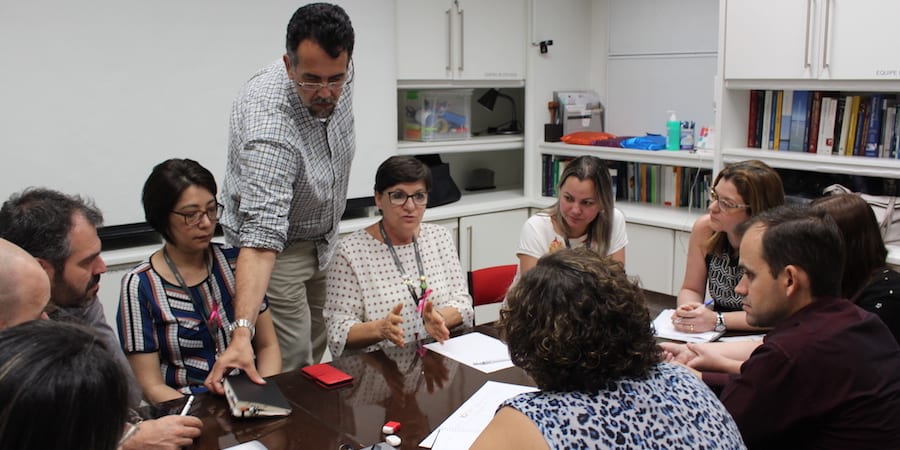
Lean and agile, how they interact
FEATURE – This article explains how Lean Thinking and the agile method can strengthen and optimize our digital transformation efforts.
Words: Carlos Baldissera, Christopher Thompson, Erasto Meneses, Fábio Trierveiler, and Maria Fernanda Vieira
We are living in a time of huge changes, characterized by uncertainty and little predictability. Adapting quickly has never been more important than today, and for businesses around the world this often means to embrace and fully leverage the potential of digital tools.
A lot has been said about lean and agile – and their synergies – but for a company facing the prospect of a digital transformation it is still difficult to understand what to do and how. In our mind, while lean helps to solve the right problems, agility supports quick adaptability and the ability to change course whenever necessary. Indeed, the essence of Agile is not to deliver faster, but to make mistakes and learn faster.
WHAT TO DO
Developing new products and services is important for companies that aim to grow, transform, and evolve in a hyper-competitive market. Too often, however, organizations offer products or services that don’t respond to customer needs or desires – a dangerous disconnect that can end up costing a lot of time and effort (not to mention resources).
To avoid this, we recommend using a model based on Design Thinking, Lean Startup and Product Discovery techniques for creating new products and services that are truly oriented towards customer satisfaction.
Such discovery frameworks and methodologies can help an organization to deeply understand the problems and generate truly value-adding solutions. They allow for a deep understanding of customer behaviors, expectations, and desires – for the creation of a better overall experience.
HOW TO DO IT
In the context of the sort of digital transformation we most often observe in companies, we notice an inadequate use of agility that prevents them from achieving the desired results. Simply creating squads won’t make you agile! In the same way, grouping people without giving them autonomy, a multifunctional context to operate in, or the systemic conditions that facilitate decision-making and the direct contact with the customer will create a lot of waste (and even generate invisible silos).
We believe that agile values and principles, when applied with purpose and in their fullness, generate the results we want and the sustainability of a digital transformation. In a structured way, using Lean Thinking as a base, the development of a lean-agile governance will enable the company to become more responsive to market trends, faster in bringing a product to market and in responding to value-oriented, strategic changes.
It’s common to find managers who still work with a traditional, command-and-control approach. This is one of the first things a lean digital transformation, with its strong emphasis on leadership development, strives to address. Leaders are the ones who will be called to disseminate lean across the organization, so it only makes sense that they are the first ones we ask to change.
The foundation of any successful transformation is a simple structure that allows for quick responses to customer changes. Such structure is supported by a leadership team that engages and leads the teams while giving them autonomy and a set of well-defined objectives. This will be informed by the ongoing search for customer value that a lean company has to engage in.
LEAN AND AGILE, TOGETHER
If we look at the concept of Improvement Kata, we see that purpose (1) is always visible to everyone taking part in the journey. To evolve from where you are (2) to the next step (3), you need a solid learning system in place that uses lean techniques (4) and quick learning cycles that rely on the agile methodology.

The Improvement Kata
Being “agile” has never been so popular, and not just in IT – after all, any company who wants to survive needs agility. These days, we are seeing a push towards agile in HR, marketing, administration and, in general, any environment that needs to reinvent itself to respond to market needs faster.
But let’s stop for a second to look at agile more in depth. Where does it come from? In the February of 2001, at a resort in Snowbird, Utah, 17 thinkers, professors, and practitioners influential in the field of software development got together. After a weekend of intense debate, they created the Agile Manifesto, with four key principles:
- individuals and interactions over processes and tools;
- working software over comprehensive documentation;
- customer collaboration over contract negotiation; and.
- responding to change over following a plan.
We think that, when they look at and decide to adopt the Manifesto, people tend to only focus on the left part of the principles (individuals and interactions, working software, etc), forgetting entirely about the items on the right. However, we shouldn’t forget that the Manifesto uses the word “over” – not the word “instead”. Being agile doesn’t mean to get rid of process altogether. Just “because I am agile”, I won’t replace contracts with post-it notes! We need balance in all things.
AGILITY IS A MEAN, NOT THE END
Whenever you are in doubt on “how perfectly” you are applying a particular tool or executing a certain practice or wonder “how agile” your transformation truly is, consider that purpose always needs to come first. If your organization is adapting at the right speed and moving in the right direction, with happier customers and workers and a healthier business, you are on the right track.
Think of your organization’s journey as a marathon. Now, technically you don’t need sneakers to run one, but – let’s face it – wearing them is much better option than running barefoot. Agile is the same: it doesn’t guarantee better results, but it gives you the tools that maximize your chances of getting them.
The quest for agility is nothing new in companies, but too many still don’t understand its true meaning. Being agile is not necessarily about delivering faster, but about learning faster and adapting faster to our changing purpose. And to become truly agile, you are better off if you combine agile practices with Lean Thinking. Alone, the dynamism afforded to you by agile won’t be enough to turn things around in a sustainable way – that’s where the solid foundation provided by lean comes into play.
THE AUTHORS

Carlos Baldissera is Manager of Lean Digital Transformation at Lean Institute Brasil.

Christopher Thompson is Director at Lean Institute Brasil.

Erasto Meneses is Head of Lean Digital Transformation at Lean Institute Brasil.

Fábio Trierveiler is Manager of Lean Digital Transformation at Lean Institute Brasil.

Maria Fernanda Vieira is a lean specialist at Lean Institute Brasil.
Read more


VIDEO - The CEO of a cancer center in Brazil gives us a tour of the their obeya room, taking us through their strategy deployment and explaining how it supports their mission of reducing the burden of cancer.


FEATURE – Why do lean and green go hand in hand? In the experience of this university in Edinburgh, they are both about respecting people and thinking holistically.


ARTICLE - Networking and learning from other practitioners is for many the number-one reason to attend a lean event. The Lean Summit France 2016, in Lyon on April 6-8, will be a great opportunity to network with like-minded people and to understand how a lean CEO thinks.


INTERVIEW - Festo’s lean journey improved competitiveness by embedding Lean into daily operations, strengthening leadership engagement, accelerating innovation, and turning Bulgaria into an internal hub for innovation.

